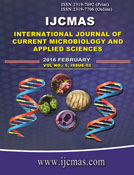


 National Academy of Agricultural Sciences (NAAS)
National Academy of Agricultural Sciences (NAAS)

|
PRINT ISSN : 2319-7692
Online ISSN : 2319-7706 Issues : 12 per year Publisher : Excellent Publishers Email : editorijcmas@gmail.com / submit@ijcmas.com Editor-in-chief: Dr.M.Prakash Index Copernicus ICV 2018: 95.39 NAAS RATING 2020: 5.38 |
A biofilm is an accumulation of microorganisms embedded in an exo-polysaccharide matrix of microbial and host origin called Polysaccharide Intercellular Adhesin (PIA). They pose a great threat to indwelling devices causing slow, persistent infections; thereby interfering with antibiotic therapy. This study was carried out to isolate and identify the bacteria and fungi from the tips of urinary catheters, to determine their anti-microbial susceptibility patterns and to detect their ability to produce biofilm by three different methods. 132 urinary catheter tips were collected from patients admitted into various wards and the organisms isolated were subjected to three different tests to detect their ability to produce biofilms, i.e., a) Tube Method, b) Congo Red Agar method and c) Tissue Culture Plate method. 49 samples showed culture positivity; out of which, 18 produced biofilms. TCP method detected 42% biofilm producers whereas Tube method and Congo red agar method detected 32% and 26% respectively. Antimicrobial susceptibility testing was done and increased resistance was shown by biofilm producers. The information on the capacity of a clinical isolate to produce biofilm would help a clinician to evaluate the measure of its virulence and devise an appropriate treatment plan for the patient
 |
 |
 |
 |
 |